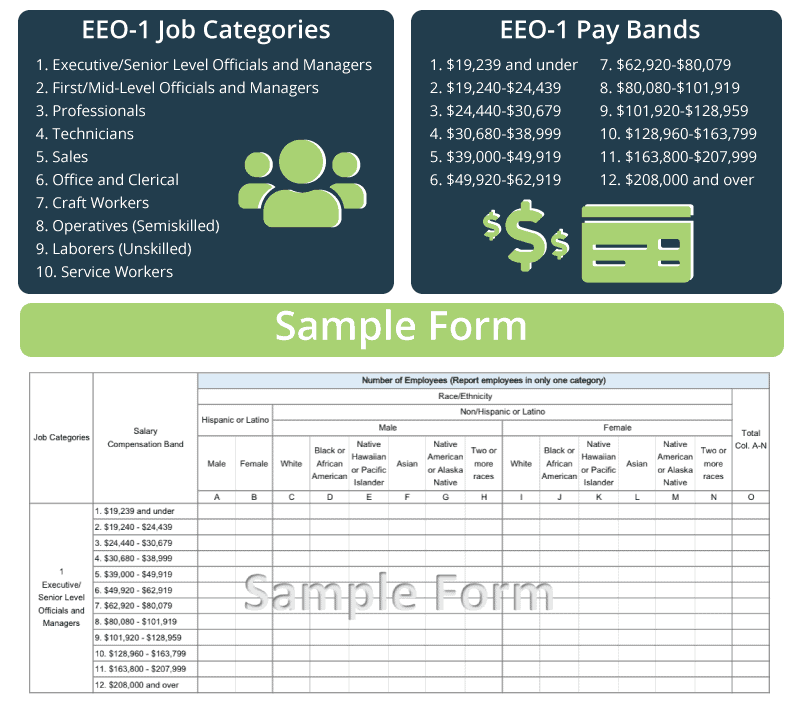HR professionals can stop holding their breath: the U.S. Equal Employment Opportunity Commission (EEOC) announced the due date and requirements for the EEO-1 Component 2. So, what now?
Key points:
- Despite ongoing litigation, the EEOC has decided to collect a snapshot of data from 2017 and 2018 for the newly required Component 2 of the EEO-1 report.
- Employers are required to submit Component 2 data to the EEOC by September 30, 2019.
- Many employers are concerned about how the expanded requirements will be used by the EEOC.
HR professionals finally know the outcome of the EEOC’s decision around the newly-required Component 2 of the EEO-1 report. Litigation continues, but the EEOC has decided to collect a snapshot of data from 2017 and 2018 for this new component of the annual report.
You have until September 30, 2019 to collect and submit 2017 and 2018 data, including hours worked and pay information from employee W-2s. Similar to the requirements of Component 1, the data needs to be organized by race, ethnicity, and sex. Once complete, the data must be uploaded via CSV file to the EEOC website. The EEOC site also provides a list of FAQs and instructions to help you navigate the intricacies of the EEO-1 report.
What remains unanswered is how the EEOC plans to use the new information. Component 1 of the report has not changed: it will continue to gather data surrounding job category, sex, race, and the ethnicity of employees. The EEOC uses this information to support civil rights enforcement and to analyze employment patterns.
Component 2 takes the data collection a step further by asking for a breakdown of hours worked and pay information from Box 1 of employee W-2s (also by ethnicity, race, and sex). The EEOC wants to collect this information to analyze and address the gender pay gap, and to ultimately identify industries and occupations where pay discrepancies are most common.
In addition to the cost and administrative burden, employers are concerned that more businesses will be hit with EEOC discrimination claims resulting from false positives. Many variables impact how employees are paid. Without context, the limited data shown in Component 2 will be left to interpretation.
“W-2 gross income includes other nondiscriminatory variables that may impact pay, including shift differentials, bonuses, commissions, and overtime compensation. While this data may provide the agency with a broader view of pay practices, collecting this data will not allow the EEOC to evaluate comparable compensation data points.”—Janese Murray, SHRM
Employers who are concerned that their data will paint a skewed portrait of how employees are paid can take proactive steps to identify discrepancies, take corrective action, or prepare to explain false positives.
While an appeal to the decision has been filed, the Component 2 order remains active. It’s possible that in the future the requirement will change, but employers shouldn’t hold their breath. For now, you must prepare to file Component 2 data before September 30, 2019.
How’d we get here?
Since 1966, the EEOC has required companies with 100 or more employees, and Federal contractors with 50 or more employees to submit EEO-1 reports. The report displays the representation of men and women in five racial/ethnic groups across ten job categories. The categories represent different levels of employment opportunity, such as craft workers, laborers, technicians, managers, and professionals.
In 2016, the EEOC proposed gathering compensation data about these employees and sought approval from the Office of Management and Budget (OMB). The OMB approved their proposal and the EEOC announced that filers would be required to submit detailed information surrounding their employees’ compensation and hours worked in March of 2018. Thus, Component 2 requirement was born.
In early February of 2017, several employer groups (including SHRM) petitioned the OMB to repeal their prior approval, claiming Component 2 would be overly burdensome and the benefits did not outweigh the costs.
In August of 2017, the OMB repealed its prior approval and revoked the Component 2 requirement. Later that year, employee advocacy groups, the National Women’s Law Center and the Labor Council for Latin American Advancement, filed a lawsuit against the OMB and the EEOC seeking to overturn the ruling. The groups believed that the information would help evaluate pay disparities and better serve their clients.
In March of this year, the US District Court for the District of Columbia sided with the plaintiffs and lifted the OMBs stay of Component 2. The EEOC was ordered to collect compensation data for the calendar year 2018 by September 30. They were also required to gather an additional year of data, but were given the option to retrospectively collect 2017’s data, collect 2017 data in the current cycle, or gather information from 2019 in the next period.
The EEOC recently announced it has decided to collect two years of data in the current cycle; 2017 and 2018. And as we’ve already established, this data is due to be filed by September 30 of 2019.
Which employers are required to file the EEO-1 report?
Businesses with at least 100 employees and Federal contractors with at least 50 employees and a contract of $50,000 or more with the Federal government must file the EEO-1 form.
Private employers (excluding Federal contractors) with less than 100 employees and Federal contractors with less than 50 employees are not required to submit the annual EEO-1 report.
What now?
The situation remains fluid so employers must keep a close watch for new developments. Still, businesses who meet the criteria for filing the EEO-1 report must prepare their data in time to hit the September 30 deadline. The process of preparing Component 2 data is trickier than it may seem at first glance. Don’t underestimate the time it will take to prepare your submission.
Stay tuned: In our next EEO-1 blog, you will learn how SentricHR can help you with EEO-1 Component 2 compliance.









